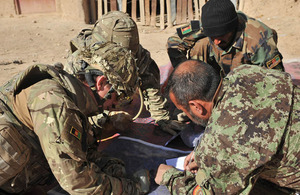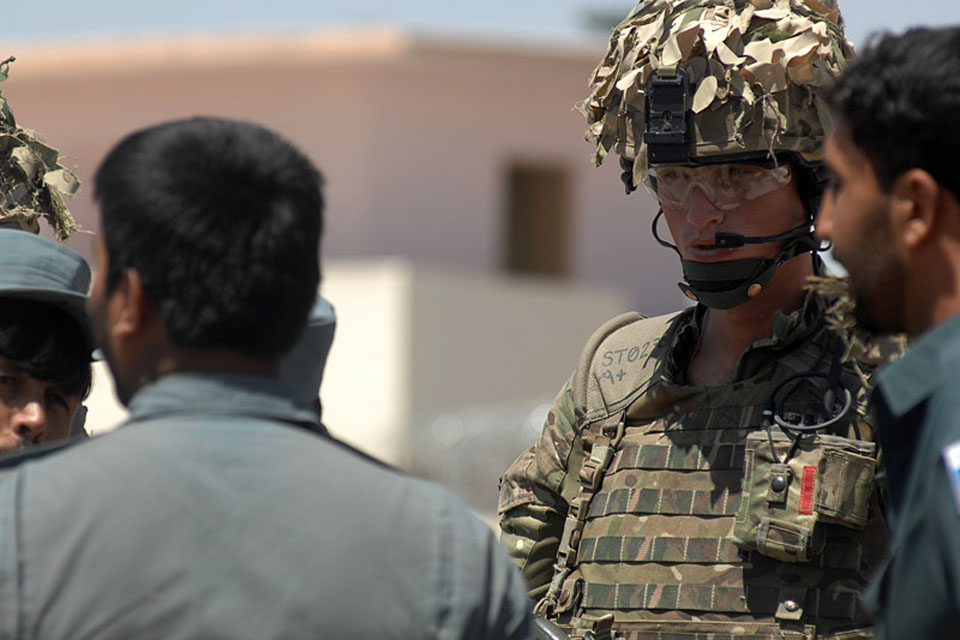Lashkar Gah transition one year on
In the year since British troops formally handed responsibility for security in Lashkar Gah to Afghan forces, the positive changes in the district are obvious, according to a former Stabilisation Advisor for the area.

Afghan National Army officers plan which compounds to search with their British advisor prior to one of their most ambitious operations in the boundary areas between the districts of Nad 'Ali, Nahr-e Saraj, and Lashkar Gah [Picture: Sergeant Wes Calder RLC, Crown Copyright/MOD 2011]
Lashkar Gah was a volatile area when British troops arrived in 2006, but since ISAF’s involvement and the handover of control to Afghan National Security Forces, day-to-day elements such as being able to travel across the town have changed significantly for the better.
The stabilisation advisor, who wishes to remain anonymous, arrived in Lashkar Gah in October 2010 and served as the area’s Stabilisation Advisor during the important transition of responsibility in July 2011. Although he left Helmand earlier this year, the advisor experienced for himself how the lives of local people have become far easier.
He explained:
By way of illustration, at the beginning of last year a drive to the north of the Helmand River could easily take two hours. A twenty-minute drive through the relatively traffic-free city streets, followed by a drive along a slow, bumpy and insecure track, which could take around one-and-a-half hours.
When I left Helmand earlier this year that same drive had changed dramatically. A ‘commute’ through the city could easily now take double the time due to traffic and busy streets; while a highway, opened last year by the Provincial Governor, cuts travel time to the north of Lashkar Gah by around two-thirds.
These are significant changes for communities which had previously found the city, its markets, clinics, and public officials, inaccessible.

Lance Corporal Aiden Cooper, 253 Provost Company of the Royal Military Police, working with Afghan Uniform Police in Lashkar Gah as a police advisor [Picture: Sergeant Andy Reddy RLC, Crown Copyright/MOD 2012]
During the transition process, the advisor and his colleagues were pleasantly surprised how the Afghan forces reacted to their new level of responsibility:
Most striking about Lashkar Gah’s entry into Transition was the great swell of Pashtun pride that accompanied it, taking some of us by surprise,” she said. “There was a sense among Afghan authorities that not only were they ready to take the step, but that it was the right and, in their view, honourable thing to do.
While July 2011 saw the transition process take root in the mindset of those political and security elites most involved in the Province’s affairs, the past year has been about the wider population fostering an appreciation that things have changed.
In support of the military effort to strengthen the ANSF, civilian agencies of British and other international aid partners are building structures of accountable government, with budgets and priorities tied to the population’s needs, and supporting efforts to reintegrate Taliban fighters.
To the wider population,” the advisor said, “international community support in Lashkar Gah, although remaining, has become much less visible.
This is a crucial step on the road to Transition, as the population comes to terms with the fact that they now have a government which, although far from perfect, can provide leadership and a degree of basic services. Confidence in security forces also continues to grow.
Although security in Lashkar Gah is good, work in other areas will continue to ensure the UK remains on track to withdraw combat forces from Afghanistan by the end of 2014.
The advisor said:
Challenges remain, yet significantly the ownership of those challenges is becoming increasingly Afghan.
One year after Lashkar Gah’s entry into Transition, if you were to have a cup of chai and discuss Transition with the elders and community leaders I used to sit with on a regular basis, I imagine they would still suggest that it is the ‘right’ path.
That’s not to say they wouldn’t want to continue to have a little support along the way.
Although, by 2015, UK forces will no longer be in a combat role or in the numbers they are now in Afghanistan, the UK will continue to have a very strong relationship with Afghanistan based on diplomacy, trade, aid and development, and the continued training of Afghan troops and building that capacity for the future.